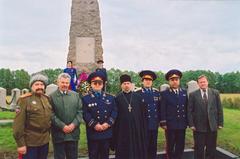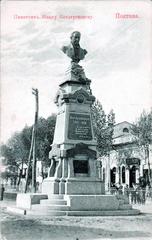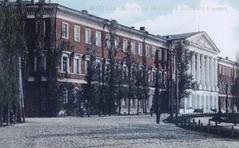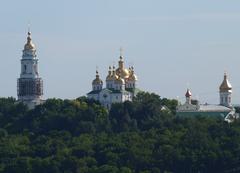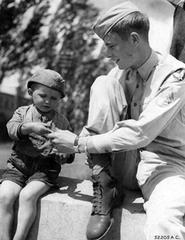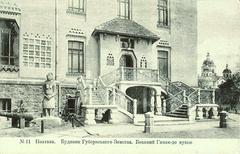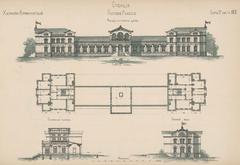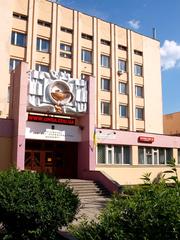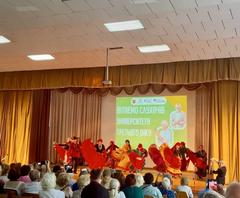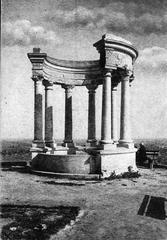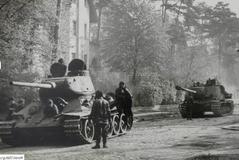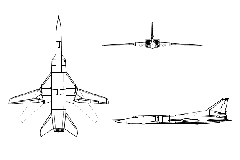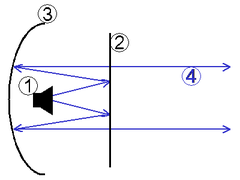
Kryvokhatky Visiting Hours, Tickets, and Historical Site Guide in Poltava, Ukraine
Date: 04/07/2025
Introduction
Nestled in central Ukraine, Kryvokhatky is a tranquil village within the Poltava region, offering visitors a window into Ukrainian rural life, history, and enduring cultural traditions. With its fertile black soil, ancient roots stretching back to the Neolithic era, and a backdrop of Cossack and literary heritage, Kryvokhatky and its surroundings are a must-visit for travelers seeking an authentic and immersive experience. This guide provides comprehensive information on local landmarks, ticketing, visiting hours, transportation, safety, etiquette, and responsible tourism to help you make the most of your journey.
Official resources for updated traveler information include the Poltava Regional Tourism Board and the Ukrainian Cultural Heritage Portal.
Historical Background of Kryvokhatky and the Poltava Region
Early Settlement and Development
Kryvokhatky is emblematic of Eastern European rural settlements, with archaeological evidence tracing habitation back to the Trypillian culture and subsequent Scythian, Sarmatian, and Slavic populations. The region’s famed chernozem (black soil) has supported centuries of agricultural prosperity, shaping the village’s economy and way of life.
The Cossack Era and Poltava’s Rise
In the 17th and 18th centuries, Poltava flourished as part of the autonomous Cossack Hetmanate. Kryvokhatky, though a small village, absorbed the era’s vibrant folk traditions and Orthodox Christian influences. The 1709 Battle of Poltava, a decisive event commemorated at the nearby Poltava Battle Museum, dramatically shifted the region’s political landscape.
Cultural Renaissance and Literary Legacy
The 19th and early 20th centuries saw a blossoming of Ukrainian literature and arts in Poltava, exemplified by figures like Ivan Kotlyarevsky. Kryvokhatky’s folk crafts, music, and storytelling traditions echo this rich period of cultural renaissance.
Soviet Era, World War II, and Revival
The 20th century brought dramatic change: collectivization, the devastating Holodomor famine, and wartime turmoil. Post-independence, Kryvokhatky and the wider Poltava region have worked to revive and preserve their unique cultural heritage through festivals, museums, and crafts.
Cultural Significance and Traditions
Kryvokhatky remains a center for traditional Ukrainian customs:
- Festivals: Malanka (New Year), Ivana Kupala (summer solstice), and harvest celebrations feature folk music, dance, and cuisine.
- Handicrafts: Vyshyvanka embroidery, weaving, and pottery are locally produced and make unique souvenirs.
- Language and Literature: The local dialect is distinctly melodic, with roots in the works of literary giants like Ivan Kotlyarevsky and Nikolai Gogol.
- Religious Heritage: Orthodox Christian traditions are visible in wooden churches and community rituals.
Key Historical and Cultural Sites in the Poltava Region
Kryvokhatky Monument
- Significance: Commemorates local historical events or figures (details may vary—check local guides).
- Visiting Hours: Open daily, 9:00 AM–7:00 PM; extended during festivals.
- Admission: Free; guided tours and special events may incur a small fee (50–150 UAH).
- Accessibility: Terrain is uneven; limited facilities for visitors with disabilities.
Poltava Battle Museum
- Location: Poltava city center
- Hours: Tuesday–Sunday, 10:00 AM–6:00 PM; closed Mondays
- Tickets: Adults 50–100 UAH; discounts for students and children
- Features: Artifacts and interactive exhibits on the pivotal 1709 battle
- Details: Poltava Battle Museum
Ivan Kotlyarevsky Estate Museum
- Hours: Daily, 9:00 AM–5:00 PM
- Tickets: 40–70 UAH, discounts available
- Exhibits: Manuscripts, period furnishings, and personal effects
Opishne Open-Air Folk Art Museum
- Hours: 9:00 AM–7:00 PM
- Tickets: 60 UAH; group discounts
- Activities: Pottery workshops and artisan demonstrations
- Info: Opishne museum info
Holy Cross Monastery
- Hours: Daily, 8:00 AM–5:00 PM
- Admission: Free; donations welcome
- Features: Baroque architecture, frescoes, and tranquil gardens
Outdoor Activities in Kryvokhatky and Surroundings
- Hiking & Nature Walks: Explore Dendropark in Poltava or stroll along Chestnut Alley, particularly beautiful in spring.
- Cycling: Vorskla Valley and local routes offer scenic rides for all skill levels.
- Water Activities: Swim or boat in Kremenchuk Reservoir; fish in the Vorskla River (local permits required).
- Picnicking: Shevchenko Park and Corpus Park provide family-friendly spaces.
Seasonal Festivals and Events
- Sorochynsky Fair: Renowned folk festival near Poltava, open 9:00 AM–8:00 PM during event days (tickets ~100 UAH).
- Harvest Festivals: Dates vary by village; check local listings for schedules.
Practical Visitor Information
Best Time to Visit
- May–September: Ideal for festivals and mild weather
- Winter: Quieter, with Christmas and New Year’s traditions
Getting There
- By Car: Offers flexibility for rural exploration
- Public Transport: Regular buses and minibuses connect Kryvokhatky with Poltava; train links from Kyiv, Kharkiv, and beyond
Accommodation
- Poltava city: Hotels, guesthouses, hostels (300–2,500 UAH/night)
- Kryvokhatky: Limited rural homestays, best booked in advance
Language
- Ukrainian is predominant; Russian spoken among older generations. English is more common in Poltava city than in villages. Learning basic Ukrainian phrases is courteous and helpful.
Safety
- Poltava region is generally safe, but always check recent travel advisories. Carry identification, respect local customs, and have comprehensive travel insurance.
Etiquette and Responsible Tourism
- Greetings: Use “Dobryi den” (Good day) and be warm in interactions.
- Dress: Modest attire is recommended for religious sites.
- Community Support: Buy local crafts and food, and consider joining cultural or volunteer initiatives.
- Environmental Care: Leave no trace—dispose of waste properly and respect nature.
Frequently Asked Questions (FAQ)
Q: Are there visiting hours or tickets for Kryvokhatky?
A: Kryvokhatky village is open year-round with no entrance fees. Some nearby museums and sites have specific hours and ticket requirements.
Q: How do I reach Kryvokhatky from Poltava?
A: By car, bus, or taxi—about 30 km from the city.
Q: Are guided tours available?
A: Yes, local agencies and guesthouses arrange tours including Kryvokhatky and Poltava attractions.
Q: Is Kryvokhatky accessible for people with disabilities?
A: Accessibility is limited due to rural infrastructure. Check with local providers for support.
Q: What are must-see sites nearby?
A: Poltava Battle Museum, Ivan Kotlyarevsky Museum, Holy Cross Monastery, and Opishne Folk Art Museum.
Safety and Travel Tips
- Monitor local advisories: Stay informed via the U.S. State Department and International SOS.
- Insurance: Ensure your policy covers medical evacuation.
- Emergency numbers: Police (102), Ambulance (103), Fire (101).
- Health precautions: Carry a medical kit; advanced care is in Poltava city.
- Cultural sensitivity: Ask before photographing people or religious sites.
Enhance Your Visit
- View interactive maps and virtual tours via travel platforms and museum websites.
Conclusion
Kryvokhatky and the Poltava region offer a tapestry of Ukrainian history, culture, and natural beauty. Whether you’re exploring centuries-old monuments, participating in lively festivals, or simply enjoying the pace of rural life, this destination enriches every traveler’s understanding of Ukraine’s heartland. Embrace the traditions, support community artisans, and travel responsibly to contribute to the preservation of this remarkable region.
For travel tips, itinerary planning, and the latest updates, download the Audiala app, visit trusted travel guides, and consult official tourism resources. Your adventure awaits in Poltava’s cultural heart!
Sources and Further Reading
- Poltava Battle Museum
- Opishne museum info
- Nomadic Matt’s Ukraine Travel Guide
- Wikipedia – Poltava
- Planet Breezy’s Poltava Guide
- Elliott Advocacy Travel Safety Guide
- Travelfreak Safety Tips
- Volunteering Ukraine: Dos and Don’ts
- Destinations Ukraine: Etiquette
- Frommer’s Dangerous Travel Destinations
- Poltava Regional Tourism Board
- Ukrainian Cultural Heritage Portal

